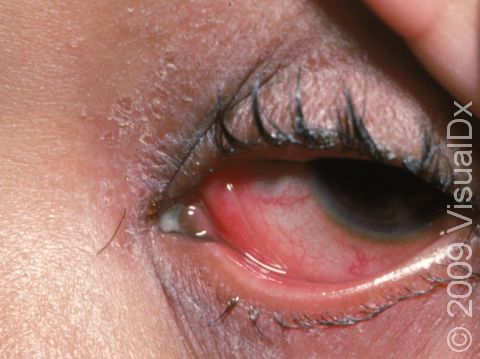Pink Eye (Conjunctivitis)
Conjunctivitis is the medical term for inflammation of the conjunctiva, or the tissue lining the inside of the eyelids and eye, commonly known as pink eye. It can be caused by viruses, bacteria, or even chemicals irritating the membranes of the eye. If a foreign body gets in the eye, it can also cause a discharge that may mimic pink eye. In general, viruses cause a more watery secretion, and bacterial conjunctivitis results in a thicker, yellowish secretion. Pink eye in the first 2-3 weeks of life can be serious.
In addition to the common bacterial and viral causes, conjunctivitis in the first few weeks of life can be the result of an infection acquired during vaginal delivery. Newborns now receive a dose of antibiotic eye drops to prevent some types of conjunctivitis that can be acquired through the birth canal.
Who's At Risk?
Pink eye is very common, especially in babies and children who are constantly touching their eyes. It is very common all over the world and can be spread by sharing objects or toys and then touching one’s eyes.
Signs & Symptoms
Signs of pink eye include a red, watery eye that appears irritated and may be draining pus or be persistently crusted. One or both eyes can be affected. The eyelids may be crusted shut in the morning, and the drainage can continue through the day. The baby may have a fever.
Self-Care Guidelines
If the pink eye is caused by a bacteria or virus, it is highly contagious, so good hand washing is necessary. Because pink eye in a newborn could potentially be very serious, you should have your baby seen by a medical professional if they have signs of pink eye.
Treatments
Your baby’s medical professional may take a sample of the discharge from the eye and send it to be cultured. This will help determine what type of bacteria, if any, is causing the infection. The medical professional may prescribe antibiotic drops for the eyes if they think the baby has a bacterial infection in one or both eyes. If the pink eye is related to another disease elsewhere in the body (such as allergies, an ear infection, or respiratory disease), oral medications may be prescribed.
Visit Urgency
Any newborn who develops signs of pink eye in the first few weeks of life should be seen by a medical professional, who can help rule out the most concerning causes.
References
Duncan JL, Parikh NB, Seitzman GD. Conjunctivitis. In: Papadakis MA, McPhee SJ, Rabow MW, McQuaid KR, Gandhi M, eds. Current Medical Diagnosis & Treatment 2024. McGraw Hill; 2024.
Horton JC. Disorders of the eye. In: Loscalzo J, Fauci AS, Kasper DL, Hauser SL, Longo DL, Jameson JL, eds. Harrison’s Principles of Internal Medicine. 21st ed. McGraw Hill; 2022.
National Center for Immunization and Respiratory Diseases (NCIRD), Division of Viral Diseases. Conjunctivitis (pink eye). Centers for Disease Control and Prevention. https://www.cdc.gov/conjunctivitis/index.html. Updated 2021 Nov 12.
Last modified on June 20th, 2024 at 7:50 am

Not sure what to look for?
Try our new Rash and Skin Condition Finder
